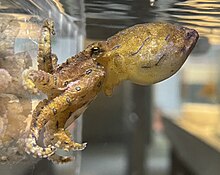Blue-lined octopus
| Blue-lined octopus | |
|---|---|

| |
| Scientific classification | |
| Kingdom: | Animalia |
| Phylum: | Mollusca |
| Class: | Cephalopoda |
| Order: | Octopoda |
| Family: | Octopodidae |
| Genus: | Hapalochlaena |
| Species: | H. fasciata
|
| Binomial name | |
| Hapalochlaena fasciata (Hoyle, 1886)
| |
| Synonyms[1] | |
| |
The blue-lined octopus (Hapalochlaena fasciata) is one of four species[2] of highly venomous blue-ringed octopuses. It can be found in Pacific Ocean waters that stretch all the way from Australia to Japan.[2] It is most commonly found around intertidal rocky shores and coastal waters to a depth of 15 metres (49 ft) between southern Queensland and southern New South Wales. It is relatively small, with a mantle up to 45 millimetres (1.8 in) in length. In its relaxed state, it is a mottled yellow-brown with dark blue or black streaks covering the whole body apart from the underside of its arms, but its vibrant blue markings appear as a warning to predators when they feel threatened.[3] Along with its other closely related species, the blue-lined octopus is regarded as one of the most dangerous animals in the sea, and its venom can be fatal to humans.[2]
Behavior[]
Blue-lined octopuses tend to swim around shallow areas of coral reefs and tide pools.[4] They often hide in crevices of reefs, empty seashells, and other ocean resources they can find to conceal their identity.[4] They are diurnal creatures, hunting crabs and small fishes during the day.[4] They do not use their venom (known as tetrodotoxin) to kill their prey, but instead trap it inside their arms and pierce them with its parrot-like beak.[4]
Lethality[]
Blue-lined octopuses can be very lethal to humans. Their saliva contain a special neurotoxin called tetrodotoxin.[5] However, the species is more likely to flee and find shelter in an encounter due to their extremely shy in nature.[3] Nonetheless, there have been at least three reported human deaths from the blue-lined octopus.[6] It poses most danger to those who pick up the octopus and physically touch it.[3]
If a human is to be attacked by the octopus, the injection may not be felt at first due to the small injection apparatus of the octopus.[3] After some time, symptoms of the injection include loss of feeling in the tongue/lips, muscle weakness/paralyzation, respiratory failure, unconsciousness, and eventually death.[3] The tetrodotoxin in blue lined octopuses is so lethal that it has been estimated that the venom from a single 25 gram octopus can kill about ten 75 kilogram humans.[5]
Reproduction[]
The blue-lined octopuses start reproducing at a year old.[4] Males seek out female companions and then pounce on them. If they are successful, the female octopus will lay 50 to 100 eggs 30 days after the encounter.[4] During the 30 days, the female octopus hide her eggs under her arms and does not leave her hiding spot until the eggs hatch.[4] After laying her eggs, the female octopus dies.[4]
References[]
- ^ "Hapalochlaena fasciata". Global Biodiversity Information Facility. Retrieved 26 May 2021.
- ^ Jump up to: a b c Kim, Kwun, Bae, Park, Hey, Hyuck, Hanna, Jinsoon (March 2018). "First reliable record of he blue-lined octopus, Hapalochlaena fasciata (Hoyle, 1886) (Cephalopoda: Octopodidae), from Jeju Island, Korea". Journal of Asia-Pacific. 11: 21–24 – via Science Direct.CS1 maint: multiple names: authors list (link)
- ^ Jump up to: a b c d e "Blue-lined Octopus". The Australian Museum. Retrieved 21 January 2021.
- ^ Jump up to: a b c d e f g h Pacific, Aquarium of the. "Greater Blue-ringed Octopus". www.aquariumofpacific.org. Retrieved 27 January 2021.
- ^ Jump up to: a b Townsend, Altvater, Thomas, Schuyler, Nette, Kathy, Jens, Michael, Qatar, Geoffrey (March 2012). "Death in the octopus' garden: fatal blue-lined octopus envenomations of adult green sea turtles". Marine Biology. 159 – via Gale Academic Offline.CS1 maint: multiple names: authors list (link)
- ^ Allan, Brownyn (2019). "Blue Ringed octopus". Australian Institute of Marine Science. Retrieved 27 January 2021.
- IUCN Red List least concern species
- Octopuses
